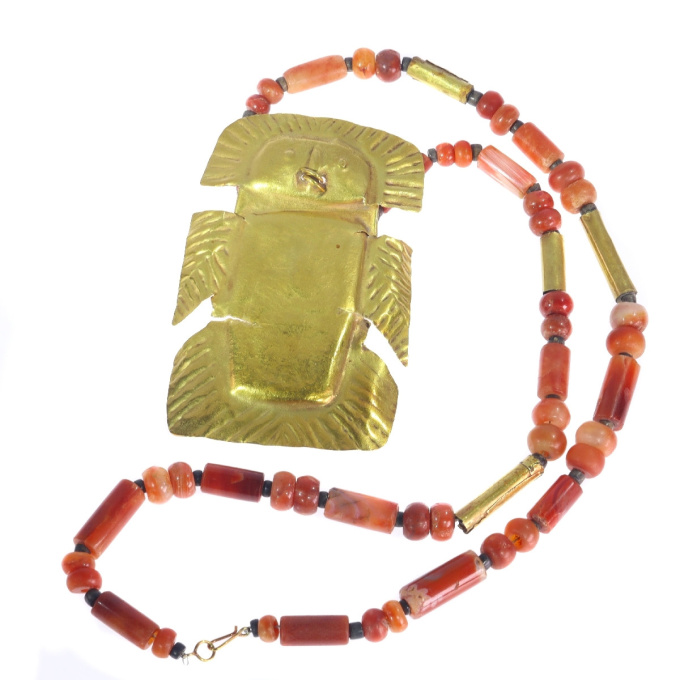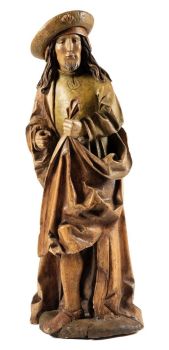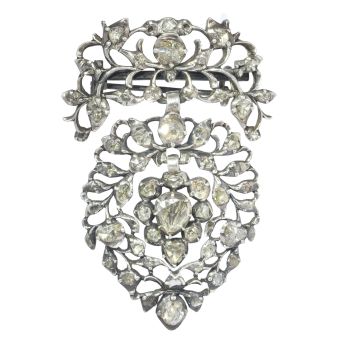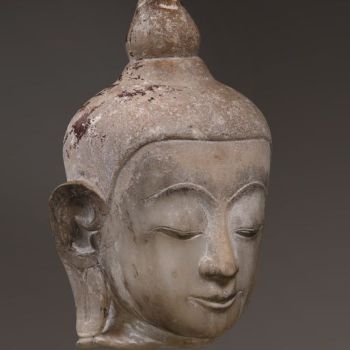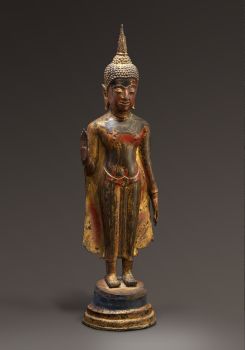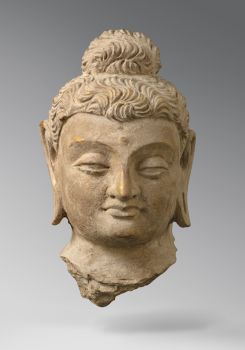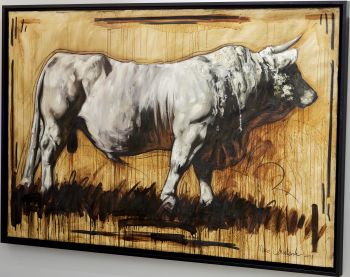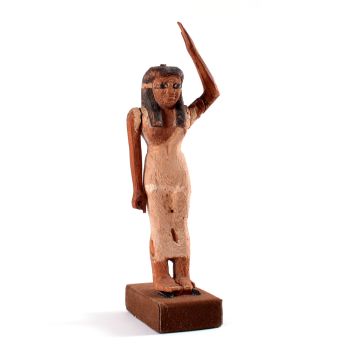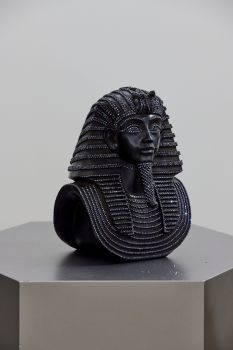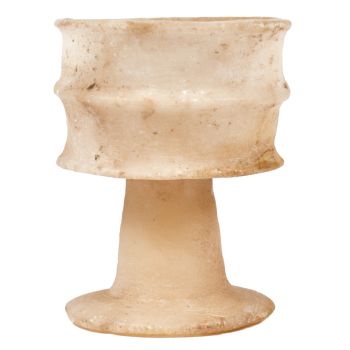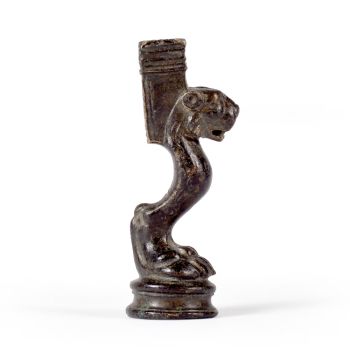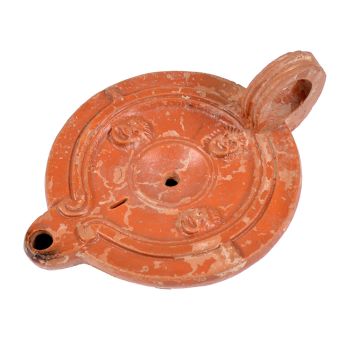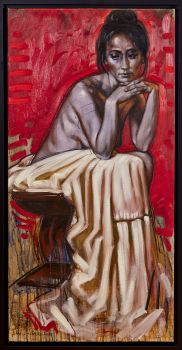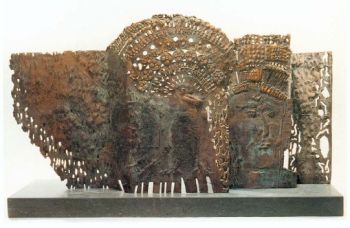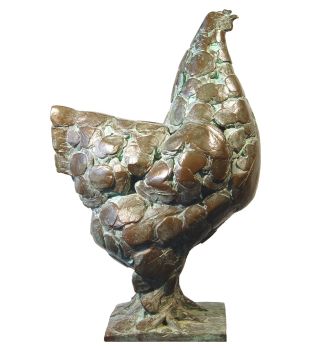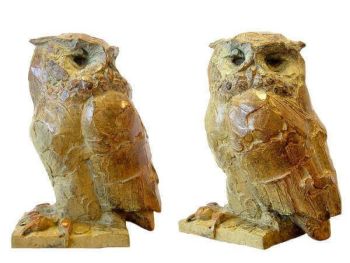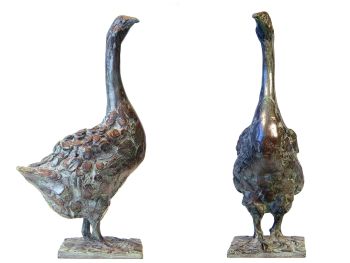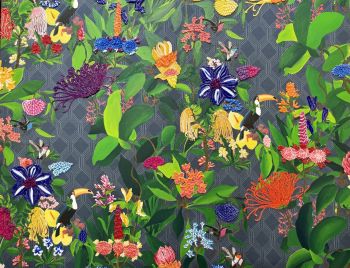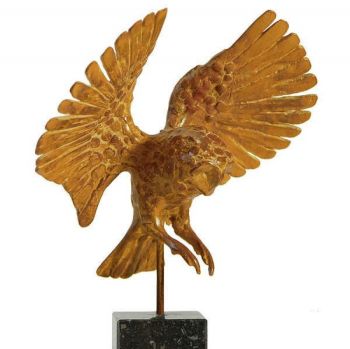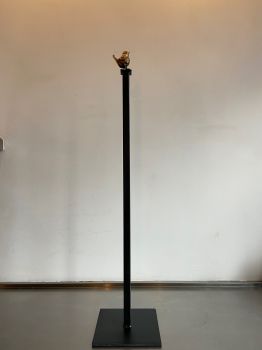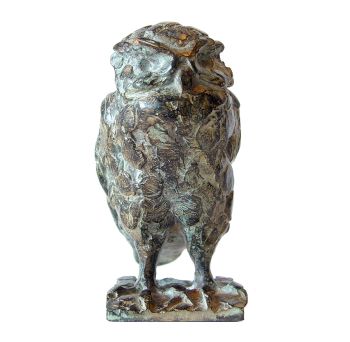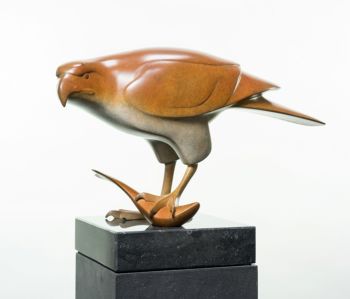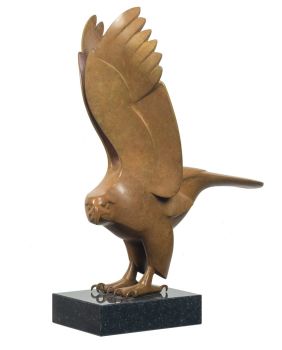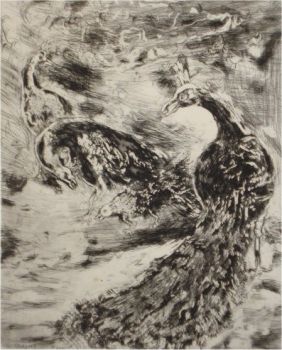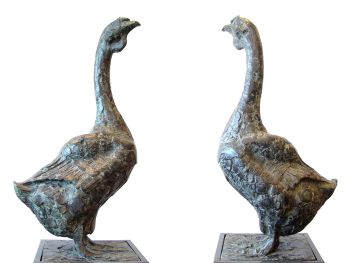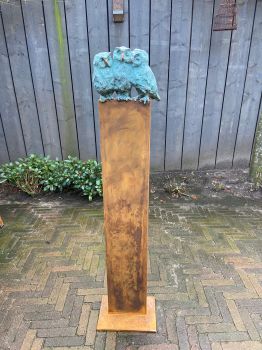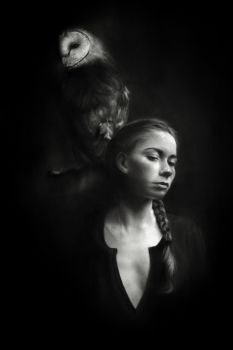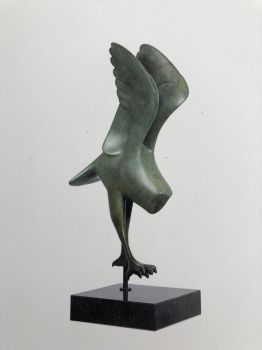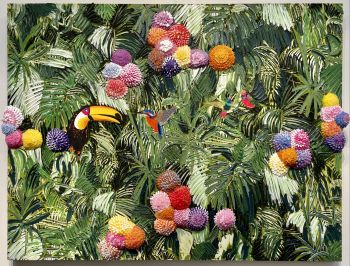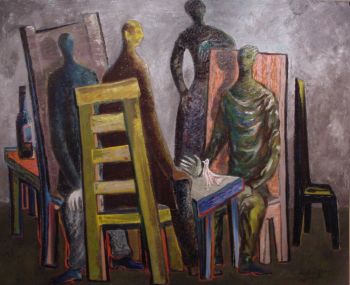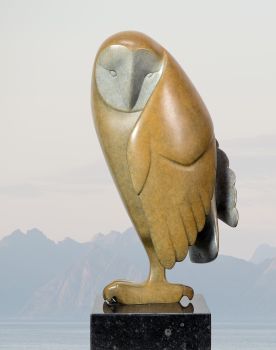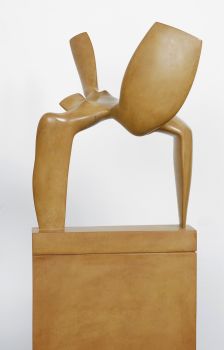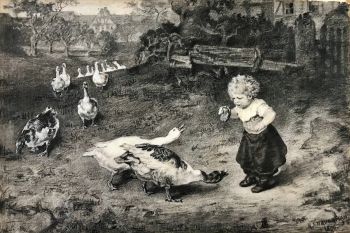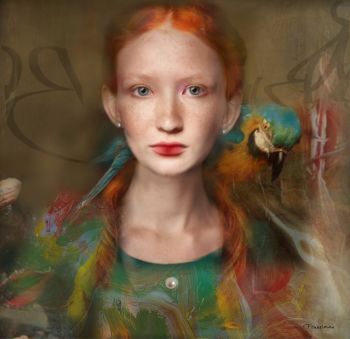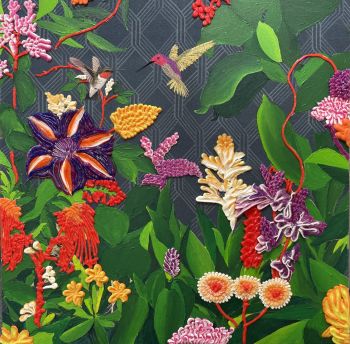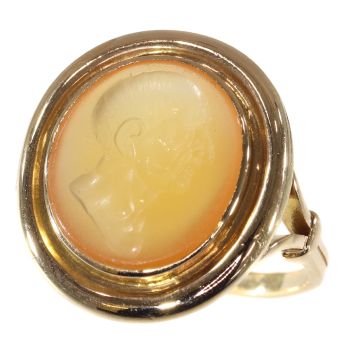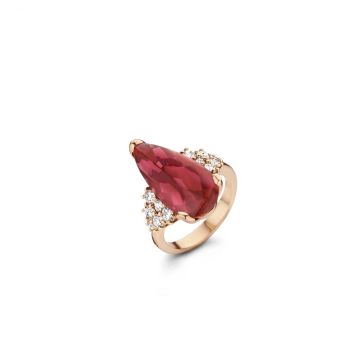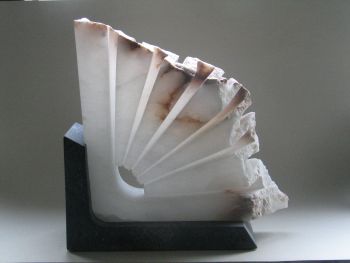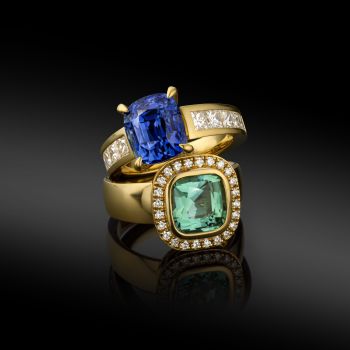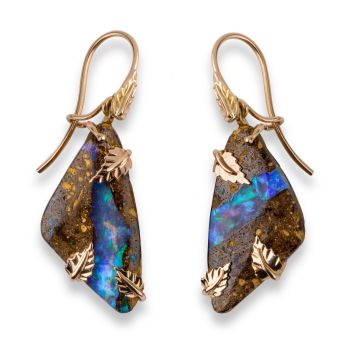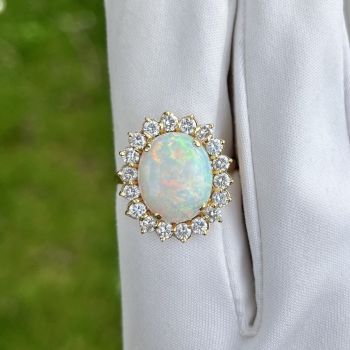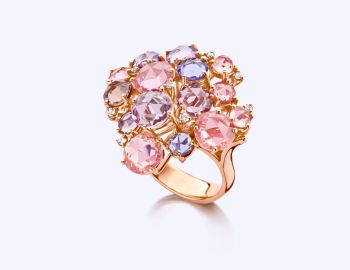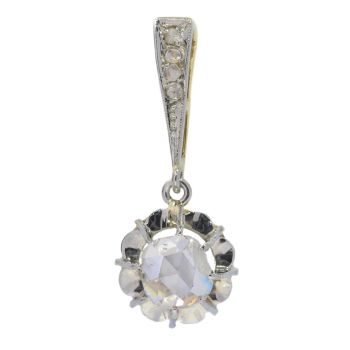1200 years old Pre-Columbian gold pendant with carnelian necklace 800
Unknown artist
CornelianGoldGemstone
Currently unavailable via Gallerease
- About the artwork
To offer a genuine ancient artefact like this requires extra research. Therefore, we've gone through our library, through museum collections and auctions, before we could make any statements about this unique piece. Now, we're exhilarated to finallyshare our findings with you.
Description
A gold sheet finely hammered into the shape of a bird with spread wings and tail forms the eye-catching pendant on this beaded necklace.
The head of the bird carries human features as well as bird features: the horizontal rings through the small pierced holes resemble a mouth or a tongue or a nose ring while the nose could just as well be a beak. Although the general appearance of thependant expresses a rudimentary finish, the bird's head and body are relatively three dimensional and almost fully flanked with slightly indented lines for feathers. The area that separates the head from the body is shaped by two side parts folded to the back of the pendant. The necklace runs discretely through these side parts on the back side, which is how these two parts replace the function of a suspension hook.
The necklace itself consists of larger orangey red beads with white veins in various shapes -most probably carnelian-, of small greyish black beads of the same shape and of gold plates rolled into scroll beads, with at the end a hook and eye closure.
Dating and symbolism
Resemblance with pre-Columbian art (400 CE - 1000 CE)
This pendant fits like a glove into the pre-Columbian era, starting from the material to the iconic shape and even its finish.
-Considering the material: Gold is regarded as a sacred medium in pre-Columbian cultures. According to the pre-Columbian mythology gold descends directly from the sun as its solidified sweat fertilising the earth.
-Considering the bird figure with spread wings and human features: In pre-Columbian cultures, shamans play an important role in society and function as a mediator between nature, the cosmos and humans. He was believed to be able to fulfill this job byshapeshifting for which the bird was considered one of the most appropriate medium. Shamans are known to wear chest plates of their totem animal to help them with their duty. These totems often combine the animal features with human facial features as aperfect symbiosis between both creatures. Furthermore, multiple pre-Columbian cultures consider birds to be messengers between gods and humans and/or to deliver seeds to humans crucial for survival. Therefore, they are almost always depicted with spreadwings as if the bird is in full flight.
-Considering the meager attention to finish: Pre-Columbian jewellery pieces give the impression of lacking attention to detail and finish. Nevertheless, this is an important characteristic element as the first and foremost goal of these pieces was to beof aid, to convey supernatural powers. As a utility instrument, its finish is of lesser importance. However, the suspension hook of such pendants are almost always incorporated into the design or even fully invisible to maintain the resemblance of thetotem as well as possible.
Besides all these similarities with other examples from the collection of the Met museum and auction items from Sotheby's, this item does carry some unique features. This gold plate is in comparison rather three dimensional and more embellished referring to the indented abstract feather lines.
Furthermore about the necklace, we've encountered this type of pendants and this type of necklaces dating from the same period in time, but we haven't yet seen them presented together. That could mean that this combination is very rare or that thependant and necklace don't belong together according to the wearing principles regarding these pieces in the pre-Columbian era.Besides that, we wish to keep in mind that necklaces with carnelian beads -or another opaque gemstone- together with gold plates rolled into scroll beads were also common in much earlier ages in de Middle East.
Another striking notability is that our most recent source of a sale of such an antique pendant (without necklace) dates back from an auction by Sotheby's in 2004.
Of course, we're very much open for any information from experts in this field.
Antique jewelry object group
Pendant with necklace.
Period
ca. 400 CE
Condition
Very good condition, especially considering that we can safely state that this piece dates from well before the common era.
-More info on our condition scale
Country of origin
South-America
Style
Pre-Columbian
Material
Not tested, but a high alloy of gold (18K+).
Precious stones
-14 -most probably- carnelian cylindrical beadswith a height varying between 13,09mm (0,515 inch) and 22,37mm (0,881 inch), and a diameter between 5,18mm (0,204 inch) and 8,98mm (0,354 inch).
-34 -most probably- carnelian rounded barrel beadswith a height varying between 4,57mm (0,180 inch) and 6,65mm (0,262 inch), and a diameter between 6,54mm (0,257 inch) and 11,02mm (0,434 inch).
-38 (+14 at the back of the pendant)black to grayish beads -resembling lava stone- varying in height around 2,00mm (0,079 inch) and in diameter around 4,00mm (0,157 inch).
Please note:
-Colour stone weights are not provided, since we do not wish to remove the beads from their necklace to preserve the integrity of the artefact.
-It is a common practice to treat gemstones to intensify their clarity or colour. However, we don't expect this for these beads, considering the type of stone and the age of the piece. Therefore, the beads in question have not been tested.
-Furthermore, the value of this artefact lies in its authenticity and age, not in the value of the materials used.
Birthstones
Carnelian is the birthstone (or month stone) for July.
More info on birthstones.
Function
According to our sources, this pendant could have belonged to a shaman of a pre-Columbian society and serve as a totem of his shapeshifting ability into a bird.
Provenance
This extraordinary piece came to us via the heirs of Lutgart Simoens. This lady was one of the most popular radio hostesses in Belgium and the Netherlands. Writer Paul Van Deuren has published a portrait book of her, which is covered by a photo ofSimoens while wearing this specific necklace:
Van Deuren, P., (1983), "Lutgart Simoens: Een leven vol radio - A life full of radio". Published by Pencoprint in Wilsele (BE). (ISBN: 9070 44 773 8)
Dimensions
Length of beaded necklace: approx. 62,00 cm (24,41 inch).
Size of pendant (length x width x thickness): ca. 9,40cm (3,70 inch) x 6,20cm (2,44 inch) x 0,29mm (0,011 inch).
-See picture with a ruler in millimeters and inches.
Weight 78,20 gram (50,28 dwt)
Adin Reference Nº: 21055-0157
Sources
Other than the collections on Metmuseum.org and Sothebys.com, the book "Kracht van de zon: Het goud van Colombia - Power of the sun: The gold from Columbia" by Frank Herreman and Mireille Holsbeke offers an extensive catalogue with historical information about pre-Columbian artefacts and gold. (ISBN: 90-5349-077-9)
Copyright photography
Adin, fine antique jewellery
Additional information
our latest acquisitions
jewelry glossary
wall of fame
visit us in Antwerp
subscribe to our mailinglist - About the artist
It might happen that an artist or maker is unknown.
Some works are not to be determined by whom it is made or it is made by (a group of) craftsmen. Examples are statues from the Ancient Time, furniture, mirroirs, or signatures that are not clear or readible but as well some works are not signed at all.
As well you can find the following description:
•“Attributed to ….” In their opinion probably a work by the artist, at least in part
•“Studio of ….” or “Workshop of” In their opinion a work executed in the studio or workshop of the artist, possibly under his supervision
•“Circle of ….” In their opinion a work of the period of the artist showing his influence, closely associated with the artist but not necessarily his pupil
•“Style of ….” or “Follower of ….” In their opinion a work executed in the artist’s style but not necessarily by a pupil; may be contemporary or nearly contemporary
•“Manner of ….” In their opinion a work in the style of the artist but of a later date
•“After ….” In their opinion a copy (of any date) of a work of the artist
•“Signed…”, “Dated….” or “Inscribed” In their opinion the work has been signed/dated/inscribed by the artist. The addition of a question mark indicates an element of doubt
•"With signature ….”, “With date ….”, “With inscription….” or “Bears signature/date/inscription” in their opinion the signature/ date/ inscription has been added by someone other than the artist
Artwork details
Related artworks
Unknown artist
An Indian silver filigree casket with hinged coverearly 20th
Price on requestZebregs & Röell - Fine Art - Antiques
1 - 4 / 12Unknown artist
The bell of the VOC fortress in Jaffna, Sri Lanka1747
Price on requestZebregs & Röell - Fine Art - Antiques
 Curated by
Curated byDanny Bree
1 - 4 / 16- 1 - 4 / 24
- 1 - 4 / 24

